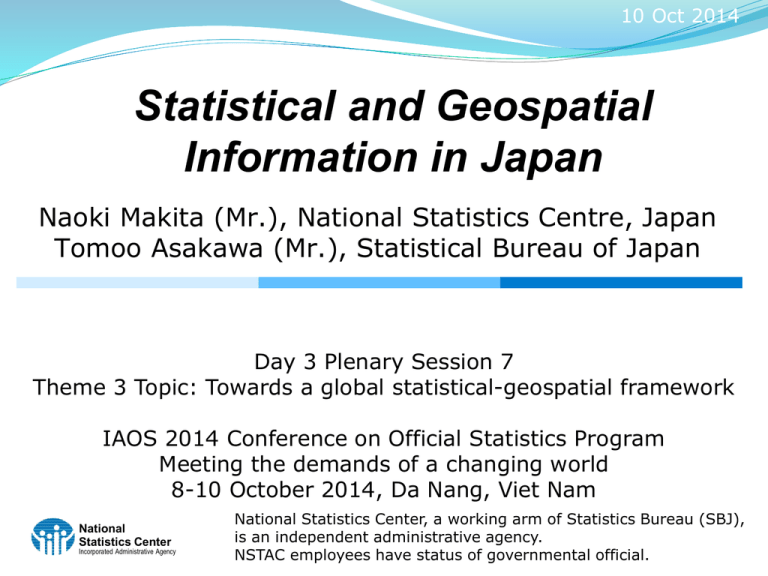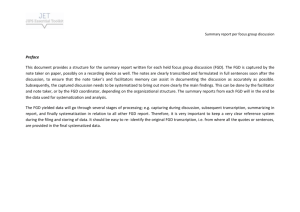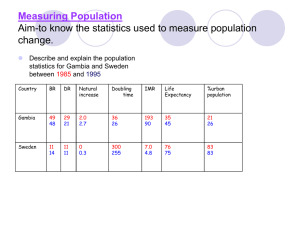Slide - IAOS 2014 Conference
advertisement

10 Oct 2014 Statistical and Geospatial Information in Japan Naoki Makita (Mr.), National Statistics Centre, Japan Tomoo Asakawa (Mr.), Statistical Bureau of Japan Day 3 Plenary Session 7 Theme 3 Topic: Towards a global statistical-geospatial framework IAOS 2014 Conference on Official Statistics Program Meeting the demands of a changing world 8-10 October 2014, Da Nang, Viet Nam National Statistics Center Incorporated Administrative Agency National Statistics Center, a working arm of Statistics Bureau (SBJ), is an independent administrative agency. NSTAC employees have status of governmental official. Outline Two geospatial frameworks Census Mapping System Data (CMS data) A framework for managing boundary data of Population Census and presenting small area statistics of the result. They were developed from 1990 Census and the boundary data has been freely disseminated since 2004 Fundamental Geospatial Data (FGD) A legal framework as the national spatial data infrastructure They has been developed progressively, and became available free of charge 2 for limited area in 2008 and for nationwide by 2012. 1. SBJ and GSI National Statistics Office Statistics Bureau of Japan (SBJ), Ministry of Internal Affairs and Communications Statistics Act (1947) National Mapping Office Geospatial Information Authority of Japan (GSI), Ministry of Land, Infrastructure, Transport and Tourism Survey Act (1949) Basic Act on the Advancement of Utilizing Geospatial Information a.k.a. National Spatial Data Infrastructure (NSDI) Act 3 (2007) 2. Geostatistics by SBJ SBJ has two Geographic Information Systems. 2.1. Census Mapping System An administrative tool for managing Enumeration District maps of Population Census 2.2. statistics GIS A website for drawing thematic maps 4 2.1. Census Mapping System SBJ has developed CMS to facilitate Enumeration District mapping since 1990 Population Census. CMS stores boundary data of sub regional statistical units in combination with statistical data. 5 2.1. Census Mapping System In Japan Population Census is conducted every five years. Every time before Population Census is conducted, Enumeration Districts (EDs) are demarcated. SBJ gives municipalities the use of the boundary data of the preceding CMS data and commercial-based residential maps (as referential base maps) Entrusted by SBJ, municipalities update the boundary data to produce ED maps, and submit them to SBJ. • Field examination of boundary data reflecting topographic and national terrestrial features • Revision of boundary data • Drawing up lists of corresponding codes for the BUBs and the newly defined EDs and ABs + 6 2.1. Census Mapping System Hierarchy of boundary data stored in CMS Type Division Note Prefecture Adminis- to, do, fu and ken • trative Municipality • unit city, town and village First tier of local government Second tier of local government Address Block • Boundary intending to simulate (AB) Community Boundary. # as of 2010Pop.Census 47 1,728 217,400 Cho cho-aza tou • Statistical unit Enumeration District (ED) • Basic Unit Block (BUB) • Boundaries based on the number of household (around 50 for each ED to assign an enumerator to deliver and collect questionnaires). The sampling frame for many statistical surveys. Elemental (smallest) boundaries expected to be stable over time 1,010,340 1,885,188 7 2.1. Census Mapping System In urban areas, they are practically the same. Hierarchy of boundary data stored in CMS They are mostly similar, but not identical. Type Division Note # as of 2010Pop.Census Prefecture A primary statistical unit Official municipalities' 47 Adminis- to, do, fu and ken • First tier of local government for disseminating trative subdivision Municipality • Second unit small area statistics tier of local government 1,728 city, town and village Address Block • Boundary intending to simulate (AB) Community Boundary. 217,400 Cho cho-aza tou • Statistical unit Enumeration District (ED) • Basic Unit Block (BUB) • Boundaries based on the number of household (around 50 for each ED to assign an enumerator to deliver and collect questionnaires). The sampling frame for statistical surveys. Elemental (smallest) boundaries expected to be stable over time 1,010,340 1,885,188 8 2.1. Census Mapping System Application of CMS Densely Inhabited Districts (DIDs) (1960-) CMS supports calculation of population density to determine DIDs DIDs in Tokyo suburb http://www.stat.go.jp/data/chiri/gis/index.htm (in Japanese language) 9 2.1. Census Mapping System Application of CMS Grid Square Statistics (1970-) CMS supports assigning BUBs to Grid Squares for aggregation Total Population, 2010 all Japan at Basic Grid Square level http://www.stat.go.jp/english/data/chiri/map/c_koku/2010.htm 10 2.1. Census Mapping System Application of CMS Dissemination CMS data facilitate advanced geostatistical analysis statistics GIS (c) ESRI (c) ZENRIN City planning, disaster management, area marketing, etc. (c) KOKUSAI KOGYO CO., LTD. Solution providers in private sector 11 2.2. statistics GIS statistics GIS is an information system for drawing thematic maps as part of “Portal Site of Official Statistics in Japan” (e-Stat). In 2004 SBJ open a website for disseminating statistical data of Population Census along with boundary data of Address Block and Grid Square for free. In 2008, SBJ with the collaboration of other statistical departments launched e-Stat to provide statistical data across all ministries free of charge. 12 The above website was merged into e-Stat , 2.2. statistics GIS A snap shot of statistics GIS (www.e-stat.go.jp) A choropleth map of population by Address Block (Population Census 2010 ) statistics GIS is in Japanese language only. e-Stat, developed by SBJ with the collaboration of Ministries and Agencies, is managed by National Statistics Center (NSTAC) 13 3. Fundamental Geospatial Data National Spatial Data Infrastructure Act Enacted in 2007, the NSDI Act is to provide an overarching legal framework on how geospatial information should be developed, distributed and used in the nation. Fundamental Geospatial Data The Act defines FGD as the NSDI. FGD is compliant with Japan Profile for Geographic Information Standards (JPGIS). JPGIS is defined in accordance with ISO 19100 series standards. www.gsi.go.jp/kiban (in Japanese) 14 3. Fundamental Geospatial Data FGD are freely downloadable from the GSI website. In fiscal 2008, FGD of 1:25,000 in scale for the entire country were released. At the end of fiscal 2011, highly precise 1:2,500 FGD covering nearly all of Japan’s urban planning zones were released. Japanese fiscal year starts from April to March next year Today, FGD are revised progressively, and revised data are released every quarter. Areas designated for urban planning 15 3. Fundamental Geospatial Data FGD are utilized broadly. Urban planning Disaster prevention Road management Real estate taxation Agriculture Forestry Tourism … Showcase booklet of FGD applications http://www.gsi.go.jp/kiban/fgdindex.html (in Japanese) 16 3. Fundamental Geospatial Data FGD consists of 13 components 17 4. Fundamental Geospatial Data FGD supplemented with additional data (vegetation, cliffs, structures, etc.) can be seen on the web as GSI Maps. 18 portal.cyberjapan.jp (in Japanese) 4. Commercial maps Aside from maps produced by GSI, commercial maps with rich neighboring information has been evolved in Japan. GSI Maps (c) GSI Google Map (c) Google, (c) ZENRIN 19 4. Commercial maps In particular, commercial residential maps are widely used. Many administrative institutions, even police stations and fire departments, rely on them. GSI Maps (c) GSI Commercial Residential Maps (priced) (c) ZENRIN Covering 99% municipalities in Japan, the residential maps feature the names of each building and residence as well as names of 20 streets and crossings. 4. Commercial maps Commercial maps are very popular for their rich neighboring information, though, their digital maps are not necessarily guaranteed to be compliant with FGD, yet. Commercial maps are produced in general based on maps of GSI with additional information from maps of municipalities (urban planning maps, road management maps, etc.) as well as information collected by field surveyors. In effect, many map users utilize maps of GSI and commercial maps all together, with little problem for most cases. 21 4. Commercial maps A hazard map, Landslide Disaster Portal Hiroshima, is viewable over five different interchangeable base maps. Vulnerable zones are overlaid with maps :from GSI maps, municipalities' original maps (urban planning maps, etc.) to commercial maps. (c) OpenStreetMap (c) Takehara City (c) GSI (c) Microsoft, (c) ZENRIN (c) Google, (c) ZENRIN www.sabo.pref.hiroshima.lg.jp 22 5. CMS data and FGD The boundary data of Population Census have been demarcated by municipalities for a long time. CMS data launched in 1990 don't have direct relation with FGD. While FGD of highly precise level has been made available since March 2012, the boundary data of CMS data for the forthcoming 2015 Population Census will be revised by municipalities with reference to commercial residential maps. Therefore, the 2015 CMS data are not guaranteed to be compliant with FGD. 23 5. CMS data and FGD Possibility shall be pursued to make use of FGD for maintaining the boundary data of CMS data. Obstacles: differences between the two frameworks such as Concepts It is not easy to converge Address Blocks with Community Boundaries, some of which are not necessarily compatible/rational enough for statistical purpose. Frequencies of revision CMS data are updated for whole Japan all at once every 5 years while FGD are revised progressive Be that as it may, CMS data somewhat align to 24 FGD for practical use, in particular in urban areas. 5. CMS data and FGD CMS boundary (red) laid over FGD (green) (c) SBJ, (c) GSI, (c) ESRI 25 Thank you for your attention! Thanks to Shinichi SAKABE, Yukiko TACHIBANA, Takuya NOJIRI, GSI Tatsushi HABUCHI, Toshimi YAMADA, NSTAC Junji SHIRAISHI, ESRI Japan Saori AIZAWA, KOKUSAI KOGYO Makoto YAMAZAKI, ZENRIN Reference New Legislation on NSDI in Japan: “Basic Act on the Advancement of Utilizing Geospatial Information” (Hiroshi MURAKAMI, Bulletin of the GSI (Vol.55), 2008) "Geographic Boundaries of Population Census of Japan" (Naoki MAKITA, UN Statistical Geospatial Expert Group Meeting, 2013) The views and opinions expressed in this document are those of the 26 authors, and not necessarily those of the organizations to which the










